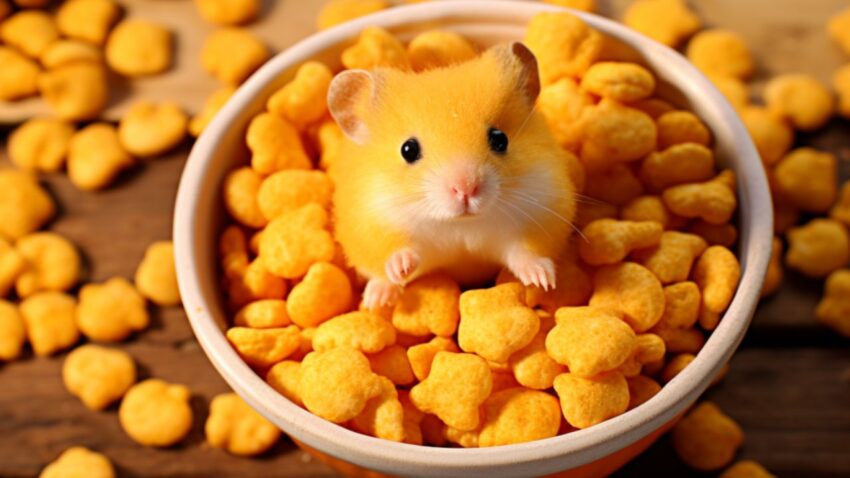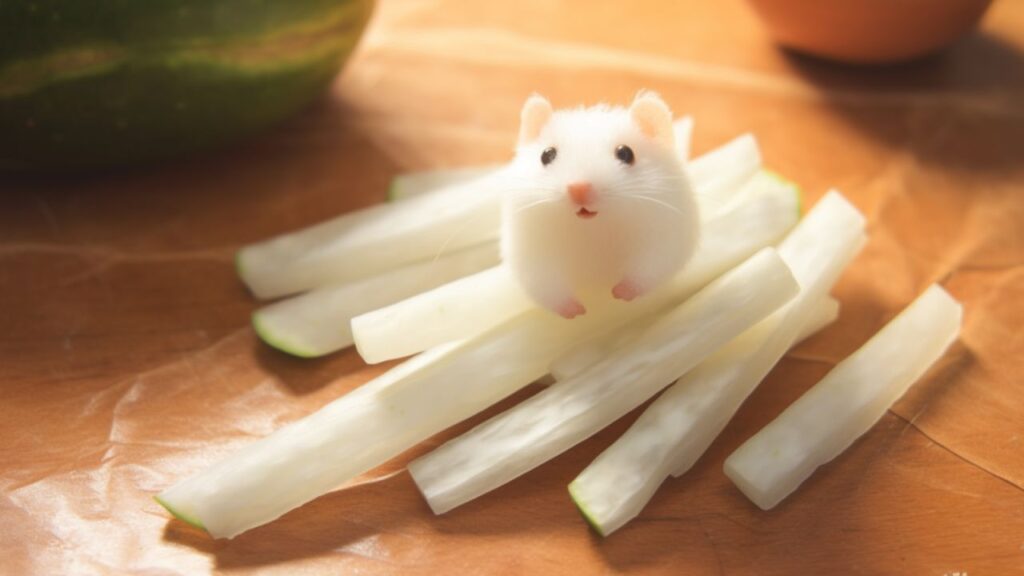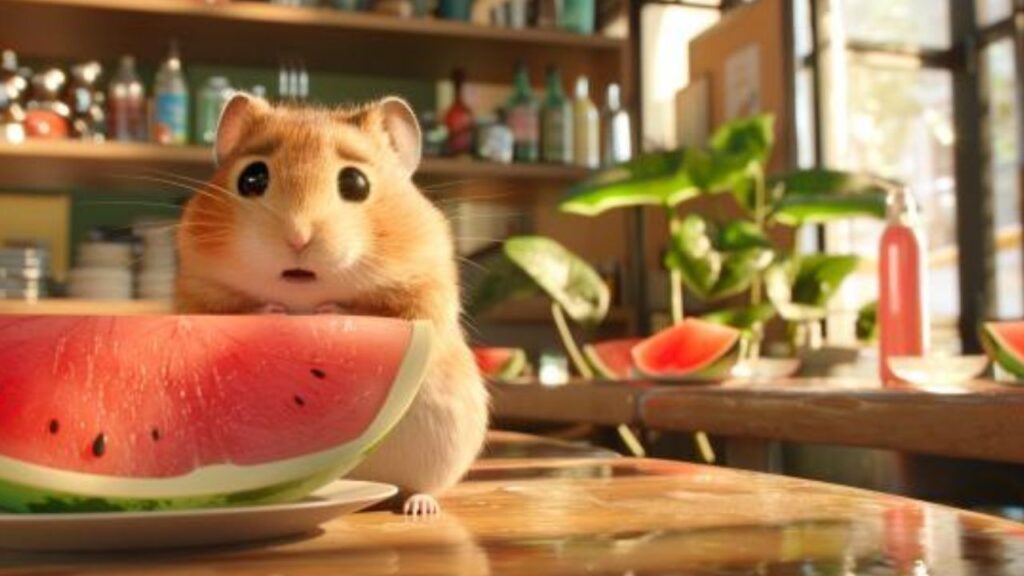TL;DR Summary
Goldfish Crackers are a popular snack that many wonder if suitable for hamsters. Upon a deep dive into the ingredients and nutritional content of the cracker and comparing it to a hamster’s dietary needs, the verdict is clear: while Goldfish Crackers aren’t toxic to hamsters, their salt content and potential artificial additives make them less than ideal. If given, it should be in moderation as an occasional treat. Always monitor your hamster afterward and consult a vet with concerns. In short, they’re not the best snack choice for hamsters. Remember, a happy hamster is a wheel-y happy you!
In the diverse landscape of snacks and treats, few have achieved the iconic status of Goldfish Crackers. Their distinctive shape, tantalizing crunch, and beloved flavors have made them a favorite across generations. But as with anything that achieves mainstream popularity, questions arise. One such question, especially prevalent among the hamster-loving community, ponders the appropriateness of these crackers as a treat for their tiny pets. As we embark on this investigation, we’ll not only delve into the history and appeal of Goldfish Crackers but also scrutinize their suitability for our furry friends. Join me, Dr. Vivian Whiskerson, as we dive into this crunchy conundrum.
Delving into the World of Hamster Snacks: The Goldfish Cracker Debate
In the vast realm of pet ownership, ensuring that our furry companions are fed with not just love, but also the right kind of nutrition, remains paramount. For hamster owners, in particular, the quest for finding that perfect treat is both an art and a science. Among the myriad of snack options, one debate has recently risen to prominence: can our little rodent friends indulge in Goldfish Crackers? These cheesy delights, often seen on children’s snack plates, have caught the attention of the rodent community. But before we give our verdict, let’s embark on a journey to understand this snack and its roots better.
The Origin and Popularity of Goldfish Crackers
The iconic Goldfish Crackers have a storied history that dates back to the 1960s. These tiny, fish-shaped treats, with their distinctive smile, were originally crafted in Switzerland and introduced to the American market by the Pepperidge Farm company. Their unmistakable crunch and delectable cheese flavor soon became a household favorite. Over the years, the brand has expanded its product line to include various flavors, from classic cheddar to more adventurous ones like pizza and even s’mores. Their widespread popularity isn’t confined to kids’ lunchboxes; many adults, too, confess to having a soft spot for these tiny, smiling fish. Their ubiquity in households has led many hamster owners to wonder: if these crackers are such a hit among humans, might they also be suitable for our little hamster pals? Let’s dive deeper to uncover the answer.
Breaking Down the Goldfish Cracker
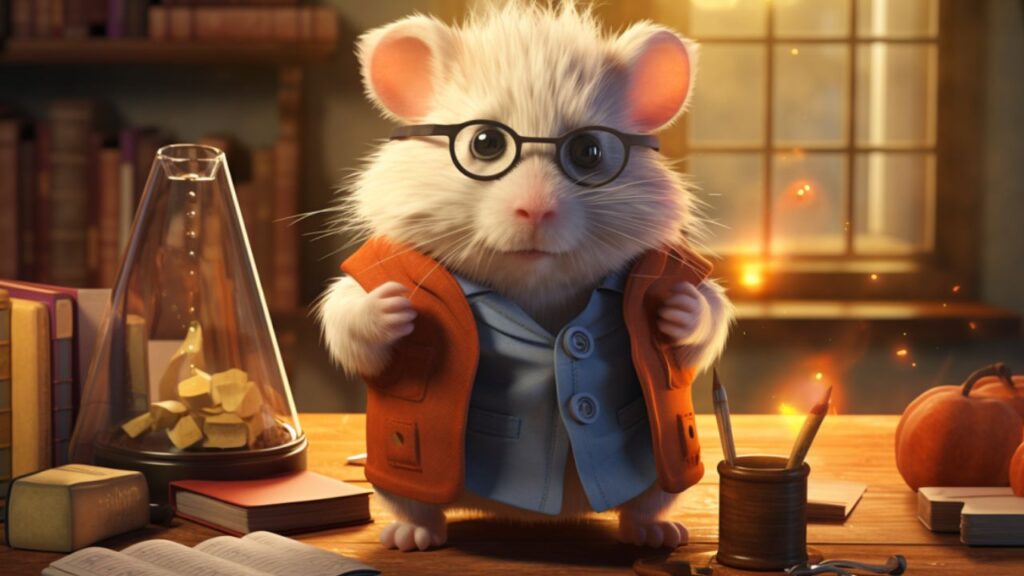
As we nibble on those delightful little fish-shaped snacks, it’s easy to overlook what’s truly behind that crunchy bite. Goldfish Crackers, beloved by many for their tangy cheese flavor and fun shape, are a product of carefully chosen ingredients. But what exactly makes up these popular treats? And more importantly, how does their nutritional profile stack up, especially when considering them as a potential nibble for our furry friends? Let’s dissect the Goldfish Cracker, examining its ingredients and nutritional content, to better understand its place in a hamster’s world.
Ingredients: What’s Really in a Goldfish Cracker?
Goldfish Crackers, with their cheerful appearance and distinct flavor, have long been a pantry staple. However, what makes up these delightful snacks might be a mystery to many. At a base level, the primary ingredients typically include unbleached enriched wheat flour, cheddar cheese, vegetable oils, salt, and a combination of leavening agents. Beyond these, there are also smaller amounts of ingredients such as malted barley flour, dextrose, and various seasonings. Some variants of the cracker might include other flavors or elements, making it crucial to read the label if considering them for unconventional uses.
Nutritional Content: Evaluating its Dietary Value
When evaluating the nutritional value of Goldfish Crackers, it’s clear they are primarily a source of carbohydrates, with a modest amount of protein from the cheese. A standard serving provides calories mainly from fats and carbs. Additionally, they contain sodium, often in amounts that might be considered high for those monitoring salt intake. Vitamins and minerals present are minimal, with some calcium and iron being the most noteworthy. It’s essential to recognize that while they might serve as a tasty snack for humans, their nutritional profile might not be ideally suited to all creatures, such as hamsters.
Hamster Dietary Essentials

Every hamster owner knows that while these little creatures might be small, their dietary needs are specific and crucial to their well-being. Hamsters thrive on a balanced mix of proteins, fibers, and healthy fats. But with the diverse range of treats and snacks available, it’s paramount to discern which can be beneficial and which might be detrimental. As we ponder the feasibility of Goldfish Crackers for our whiskered companions, understanding their essential nutritional requirements becomes imperative. In this section, we will delve deep into the dietary essentials of a hamster and juxtapose them against what Goldfish Crackers bring to the table.
Understanding a Hamster’s Nutritional Needs
Hamsters, as omnivores, have a varied diet in the wild, consisting of seeds, grains, nuts, fruits, vegetables, and even occasional insects. The balance of these nutrients is vital to ensure their overall health, vitality, and longevity.
- Proteins: Vital for growth and repair, protein is a cornerstone of a hamster’s diet. Typically, they require about 16-22% of protein in their daily intake, especially during their growth phase.
- Fibers: Fibers are essential for a hamster’s digestive health. They aid in digestion and prevent diseases related to the digestive tract. A hamster’s diet should be composed of about 6-15% fiber.
- Fats: While fats are an essential source of energy for hamsters, moderation is the key. A high-fat diet can lead to obesity and related health issues. Their fat intake should be around 4-7%.
Matching Goldfish Crackers Against Hamster Dietary Standards
Given our understanding of a hamster’s nutritional needs, it’s crucial to assess how Goldfish Crackers fare when measured against these standards.
- Protein Content: Goldfish Crackers, primarily being a grain-based snack, are not a significant source of protein. Their protein content might not align with the protein needs of a hamster.
- Fiber Content: While the crackers do contain some amount of fiber, it’s derived primarily from refined grains, which might not be the most beneficial source of fiber for hamsters.
- Fat Content: The crackers are baked and contain added fats, which could potentially tip the scales if given in large quantities, pushing a hamster’s diet towards being high in fat.
In essence, while Goldfish Crackers might seem like a fun snack, their nutritional profile doesn’t necessarily align perfectly with a hamster’s dietary essentials.
Dr. Whiskerson’s Observations & Recommendations

As someone who has dedicated their life to the in-depth study of hamsters and their unique quirks, I, Dr. Vivian Whiskerson, have had the pleasure (and sometimes the challenge) of observing these little beings in a plethora of situations. The Goldfish Cracker debate isn’t a new one, and throughout my years of research, I’ve had multiple opportunities to see hamsters interact with these popular snacks. Couple this with insights from the wider rodent expertise arena, and we are armed with a holistic view on this tantalizing topic.
Hamsters’ Interaction with Goldfish Crackers: First-Hand Observations
During controlled observational studies, hamsters were presented with Goldfish Crackers alongside their regular diet. Here’s what unfolded:
- Initial Attraction: The scent and potential crunchiness of the cracker seemed to pique the hamsters’ curiosity. Many approached the cracker, sniffed it, and occasionally took small nibbles.
- Preference vs. Regular Diet: While a few hamsters took a liking to the cracker, munching on it with fervor, many others still showed a clear preference for their usual seeds and grains. It wasn’t necessarily a unanimous favorite among the hamster participants.
- Digestive Impact: Some hamsters that consumed larger portions showed signs of digestive discomfort, such as less frequent droppings or slightly harder stools. While this wasn’t a widespread observation, it does underscore the importance of moderation and careful observation when introducing any new snack.
Feedback from the Rodent Expertise Arena
The hamster research community is vast and diverse. Over the years, various experts have shared their findings, insights, and recommendations on hamsters and their interactions with human snacks:
- Moderation is Key: Almost universally, experts echo the sentiment that if Goldfish Crackers are to be given, they should be in very moderate amounts, ensuring it doesn’t replace their regular nutritious food.
- Potential Health Concerns: Some researchers have raised concerns about the salt and preservatives in Goldfish Crackers. While these ingredients might not immediately harm a hamster, prolonged exposure or large quantities can potentially lead to health issues.
- Alternative Snacks: Many experts in the rodent field advocate for more natural snacks for hamsters, such as bits of fruits, vegetables, or unseasoned cooked meats. These align better with their natural dietary habits and can be more beneficial for their health.
In conclusion, while Goldfish Crackers might provide a momentary change for our furry friends, it’s essential to be informed, observant, and judicious in their use. After all, our primary goal is the well-being and happiness of our hamster companions.
Alternative Viewpoints

As with any topic, especially one revolving around the health and well-being of our beloved pets, there are varied opinions and perspectives. The debate over Goldfish Crackers as a hamster snack is no exception. To provide a comprehensive understanding, it’s essential to examine alternative viewpoints, weigh the pros and cons, and debunk common myths that might misguide well-intentioned hamster enthusiasts.
What Other Experts Say: The Pros and Cons
The hamster community, spanning veterinarians, researchers, and seasoned hamster caregivers, have their share of thoughts on this topic. Here’s a breakdown of the common arguments for and against the Goldfish Cracker as a snack for hamsters:
Pros:
- Occasional Treat: Some experts believe that, in moderation, Goldfish Crackers can act as an occasional treat, breaking the monotony of the hamster’s daily diet.
- Engaging Activity: The cracker’s crunchy texture provides an engaging chewing activity, which can be good for hamsters’ dental health.
Cons:
- Nutritional Mismatch: A majority voice concerns about the lack of essential nutrients in the crackers that hamsters require for their optimal health.
- Salt and Preservatives: The high salt content and the preservatives in these crackers could pose health risks if consumed regularly.
- Digestive Concerns: As observed in some studies, there’s potential for digestive discomfort or even longer-term digestive problems if hamsters ingest too many processed snacks.
Unraveling Common Myths: Setting the Record Straight
Misinformation or half-truths often circulate, leading to myths that can confuse even the most diligent hamster caregivers. Here are some common misconceptions related to this debate, and the facts that dispel them:
- Myth: “Goldfish Crackers are entirely safe for hamsters since kids consume them.” Fact: Children and hamsters have very different digestive systems and nutritional needs. What’s benign for one might not be for the other.
- Myth: “If a hamster eats it, it means it’s good for them.” Fact: Hamsters, much like us, can be drawn to foods based on flavor, not necessarily nutritional value. It’s up to caregivers to ensure their diet is balanced and healthy.
- Myth: “A Goldfish Cracker now and then won’t harm.” Fact: While occasional treats can be okay, it’s essential to observe the hamster for any signs of discomfort or adverse reactions and adjust their diet accordingly.
In the vast ocean of information and opinions, it’s always best to approach any new dietary introduction for your hamster with caution, research, and observation.
Whisker Tips
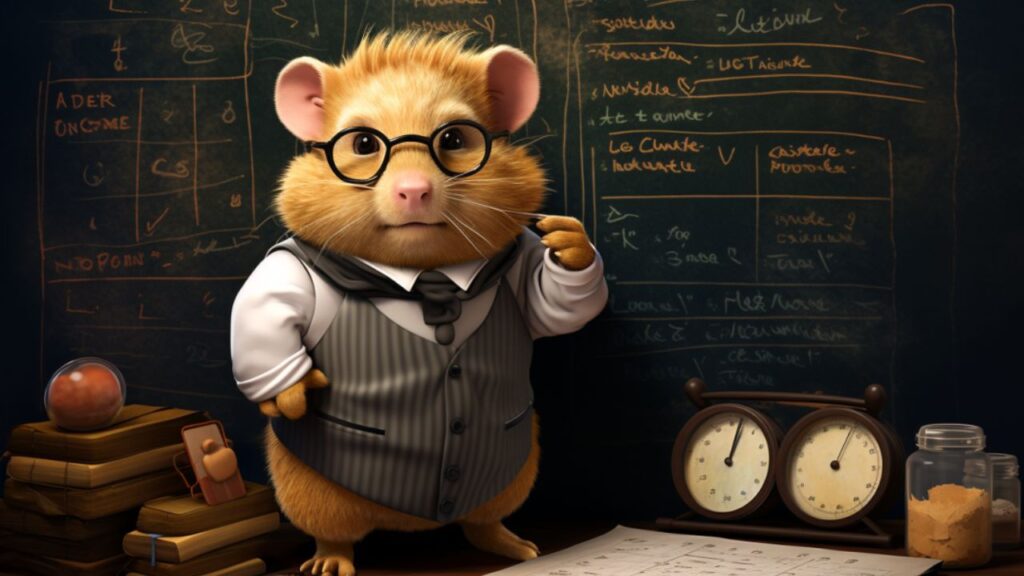
Navigating the maze of hamster nutrition can sometimes feel overwhelming, especially with the myriad of available snack options. While the core diet of a hamster is straightforward, snacks introduce an element of variability that requires a bit more finesse. In this signature ‘Whisker Tips’ section, we’ll guide you through the process of introducing snacks safely and highlight the critical signs to watch for post-snacking, ensuring your hamster remains in the pink of health.
Safely Introducing Snacks to Hamsters
Introducing a new snack to your hamster’s diet? Here’s how to do it safely:
- Start Small: As with any new food, begin with a tiny amount. This allows you to gauge your hamster’s interest and monitor for any adverse reactions without overwhelming their system.
- Monitor Closely: Keep a close eye on your hamster for at least 24 hours after introducing the new snack. Look for changes in behavior, eating patterns, or bathroom habits.
- Variety in Moderation: While it’s fun to offer a variety of treats, ensure you’re not overloading your hamster’s diet with too many different snacks at once. Stick to one new treat at a time.
- Clean Out Uneaten Snacks: If your hamster doesn’t seem interested in the snack or leaves it untouched for several hours, remove it from their habitat. This prevents the potential growth of mold or bacteria.
- Consult a Vet: If in doubt about a particular snack’s suitability, always consult with a veterinarian. They can provide guidance tailored to your hamster’s specific needs.
Signs to Watch for Post-snacking
After giving your hamster a new snack, it’s vital to observe them for any signs that the treat might not be sitting well. Here’s what to keep an eye out for:
- Changes in Droppings: If you notice a sudden change in the consistency, color, or frequency of your hamster’s droppings, it might indicate that the snack didn’t agree with them.
- Lethargy: If your hamster becomes unusually lethargic or less active after consuming a new snack, it could be a sign of discomfort.
- Loss of Appetite: A sudden loss of interest in their regular food might indicate a digestive upset.
- Excessive Thirst: If your hamster seems to be drinking a lot more water than usual, the snack might have been too salty or caused some dehydration.
- Scratching or Irritation: Some snacks might cause allergic reactions, leading to itching or skin irritations.
Remember, each hamster is unique. What suits one might not suit another. The key is observation, patience, and a dash of intuition.
Conclusion: Can Hamsters Really Munch on Goldfish Crackers?

As we near the end of this in-depth exploration, we circle back to the query that set our wheels spinning in the first place: Can hamsters really enjoy those delicious, cheesy Goldfish Crackers as a treat? Through our journey, we’ve delved into the very composition of the cracker, weighed it against a hamster’s dietary needs, and consulted with experts in the rodent realm. Now, with a plethora of information at our disposal, it’s time to revisit the central question with a fresh, informed perspective.
Revisiting the Central Question with an Informed Perspective
Hamsters, like humans, are individuals with unique tastes and dietary tolerances. Goldfish Crackers, with their cheesy allure, may tempt many a hamster. However, the intricate balance of their nutritional makeup, coupled with the potential additives, makes this snack a topic of debate in the rodent world. We’ve looked into the ingredients, considered the nutritional content, and observed firsthand interactions, all to provide the most holistic answer possible.
Sharing the Final Verdict on Goldfish Crackers for Hamsters
Given the information we’ve amassed, the verdict is nuanced. Goldfish Crackers are not inherently toxic to hamsters. However, their salt content, potential for artificial additives, and the absence of any significant nutritional value make them less than ideal as a regular treat. If you decide to offer a Goldfish Cracker to your hamster, it should be in moderation, ensuring it’s an occasional delight rather than a dietary staple. Always monitor your hamster for any changes post-snacking and consult with a veterinarian if you have any concerns.
In the grand tapestry of hamster treats, Goldfish Crackers might just be a small, cheesy thread. But, as with all threads, it’s essential to weave with care. Remember, a happy hamster is a wheel-y happy you!

